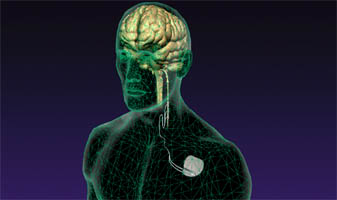Eur Arch Otorhinolaryngol. 2012 Jul 27. [Epub ahead of print]
Vagal nerve stimulation for refractory epilepsy: the surgical procedure and complications in 100 implantations by a single medical center.
Source
Department of Otolaryngology, Head and Neck and Maxillo-facial Surgery, Tel-Aviv Sourasky Medical Center, Sackler Faculty of Medicine, Tel-Aviv University, 6 Weizmann St, 64239, Tel-Aviv, Israel.Abstract
In 1997, the US Food and Drug Administration approved the use of intermittent stimulation of the left vagal nerve as adjunctive therapy for seizure control. Vagal nerve stimulation (VNS) has since been considered a safe and effective treatment for medically intractable seizures. The objective of this study is to present our experience with the surgical procedure and outcomes after VNS insertion in the first 100 consecutive patients treated at the Tel-Aviv "Sourasky" Medical Center (TASMC). All patients who underwent VNS device implantation by the authors at TASMC between 2005 and 2011 were studied. The collected data included age at onset of epilepsy, seizure type, duration of epilepsy, age at VNS device implantation, seizure reduction, surgical complications, and adverse effects of VNS over time. Fifty-three males and 47 females, age 21.2 ± 11.1 years, underwent VNS implantation. Indications for surgery were medically refractory epilepsy. The most common seizure type was focal (55 patients, 55 %). Seizure duration until implantation was 14.4 ± 9 years. Mean follow-up time after device insertion was 24.5 ± 22 months. Complications were encountered in 12 patients. The most common complication was local infection (6 patients, 6 %). Six devices were removed-four due to infection and two due to loss of clinical effect. Currently, 63 patients remain in active long-term follow-up; of these, 35 patients have >50 % reduction in frequency of attacks.VNS is a well-tolerated and effective therapeutic alternative in the management of medically refractory epilepsy. The surgical procedure is safe and has a low complication rate.- PMID:
- 22836871
- [PubMed - as supplied by publisher]
FW: The Effects Of Epilepsy On The Body
|
6:37 AM (Wednesday, October 8, 2014)
|
Hi,
I just wanted to confirm you received this and see if you have any questions.
Thanks!
http://www.healthline.com/
______________________________
From: maggie.danhakl
Sent: Monday, September 22, 2014 1:48 PM
To: vnsdepression@gmail.com
Subject: The Effects Of Epilepsy On The Body
Hi,
I hope all is well with you. Healthline just published an infographic detailing the effects of epilepsy on the body. This is an interactive chart allowing the reader to pick the side effect they want to learn more about.
You can see the overview of the report here: http://www.healthline.com/
Our users have found our guide very useful and I thought it would be a great resource for your page: http://vnstherapy-herb.
I would appreciate it if you could review our request and consider adding this visual representation of the effects of epilepsy to your site or sharing it on your social media feeds.
Please let me know if you have any questions.
All the best,
Maggie Danhakl • Assistant Marketing Manager
Healthline • The Power of Intelligent Health
660 Third Street, San Francisco, CA 94107www.healthline.com | @Healthline | @HealthlineCorp About Us: corp.healthline.com
I just wanted to confirm you received this and see if you have any questions.
Thanks!
http://www.healthline.com/
______________________________
From: maggie.danhakl
Sent: Monday, September 22, 2014 1:48 PM
To: vnsdepression@gmail.com
Subject: The Effects Of Epilepsy On The Body
Hi,
I hope all is well with you. Healthline just published an infographic detailing the effects of epilepsy on the body. This is an interactive chart allowing the reader to pick the side effect they want to learn more about.
You can see the overview of the report here: http://www.healthline.com/
Our users have found our guide very useful and I thought it would be a great resource for your page: http://vnstherapy-herb.
I would appreciate it if you could review our request and consider adding this visual representation of the effects of epilepsy to your site or sharing it on your social media feeds.
Please let me know if you have any questions.
All the best,
Maggie Danhakl • Assistant Marketing Manager
Healthline • The Power of Intelligent Health
660 Third Street, San Francisco, CA 94107www.healthline.com | @Healthline | @HealthlineCorp About Us: corp.healthline.com









